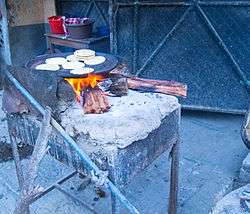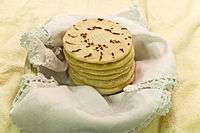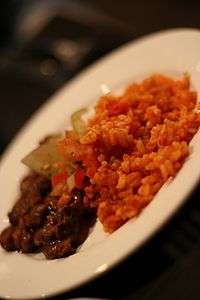Wheat tortilla
 Flour tortilla | |
| Type | Flatbread |
|---|---|
| Place of origin | Mexico |
| Main ingredients | Wheat flour |
A flour tortilla (/tɔːrˈtiːə/, /-jə/; or wheat tortilla to differentiate it from other uses of the word tortilla, which in Spanish means "small torta", or "small cake") is a type of soft, thin flatbread made from finely ground wheat flour from Mexico.
The wheat flour tortilla was originally derived from the corn tortilla, a bread of maize which predates the arrival of Europeans to the Americas. It is made with an unleavened, water based dough, pressed and cooked like corn tortillas.[1] In Spanish the word "tortilla", without qualification, has different meanings in different regions. In Spain it is an omelette; in Mexico and Central America it is a corn tortilla; and in many other places a flour tortilla.[2]
Flour tortillas are commonly prepared with meat, mashed potatoes, cheese and other ingredients to make dishes such as tacos, quesadillas and burritos (a dish originating in the Ciudad Juarez, Chihuahua, Mexico / El Paso, Texas area).
Tortillas are also very similar to the unleavened bread popular in Semitic, eastern Mediterranean and southern Asian countries, though thinner and smaller in diameter. In China, there is the laobing (烙餅), a pizza-shaped thick "pancake" that is similar to the tortilla.
Production


The wheat flour tortilla is probably best known as the tortilla and it is used to make burritos, amongst other things. [3] Wheat tortillas have also become a staple of both northwestern Mexican states (such as Sonora, Sinaloa and Chihuahua) and throughout the Southwestern United States.
Tortillas vary in size from about 6 to over 30 cm (2.4 to over 12 in), depending on the region of the country and the dish for which it is intended.
In commercial production and even in some larger restaurants, automatic machines make tortillas from dough.
History of the corn tortilla
According to Maya legend, tortillas were invented by a peasant for his hungry king in ancient times. The first tortillas discovered, which date back to approximately 10,000 BC, were made of native maize with dried kernel. The Aztecs used a lot of maize, both eaten straight from the cob and in recipes. They ground the maize, and used the cornmeal to make a dough called masa.[4]
On 22 April 1519, Spaniards led by Hernán Cortés, also known as Hernando Cortez, arrived in what is now Mexico. They found that the inhabitants (Aztecs and other native Mexican peoples) made flat maize bread. The native Nahuatl name for this was tlaxcalli.[5]
In Cortés' 1520 second letter to King Charles V of Spain, he described the public markets:
"This city has many public squares, in which are situated the markets and other places for buying and selling. . . where are daily assembled more than sixty thousand souls, engaged in buying and selling; and where are found all kinds of merchandise that the world affords, embracing the necessaries of life, as for instance articles of food. . . maize or Indian corn, in the grain and in the form of bread, preferred in the grain for its flavor to that of the other islands and Terra-firma".[6]
This bread made from maize was later given the name tortilla (little cake) by the Spanish. In parts of southern Spain, the origin of many of the Spaniards conquering America,[7] a tortilla or tortillita is a crisp, thin, circular, fried cake made of chickpea meal. These tortillas, which apparently have their roots in southern Spain's Arabic heritage which Arabs brought Spain from Greek foods, look strikingly similar to the fried maize tortilla (or tostada).
Franciscan friar Bernardino de Sahagún described how the Aztec diet was based on maize, tortillas, tamales and a wide variety of chiles. Sahagún noted that the Aztecs not only used corn in their tortillas, but also squash and amaranth, and that some varieties used turkey eggs or honey as a flavoring.[8]
Traditionally, maize tortillas were made from nixtamalized maize; kernels were soaked in a solution of lime (calcium hydroxide) and water to remove their skins; this also increases the bioavailability of then-unknown niacin. The grains were then ground into maize dough (masa). A golf ball-sized piece of dough was patted down by hand into a thin pancake shape, placed on a hot griddle (comal), and cooked on both sides. This tortilla-making process is still used today in southern Mexico.[9]
To meet the needs of big cities and the modern lifestyle, the traditional process was mechanized to increase production of tortillas. In the 1940s and 1950s, one of the first widespread uses of small gas engines and electric motors was to power wet-grain grinders for making masa. A hand press or hand patting were still used to form it into tortillas, but by the 1960s, small-scale tortilla-making machines could produce cooked tortillas every two seconds.
Tortillas today
Today, personal and industrial (Mexican-style) tortilla-making equipment has facilitated and expedited tortilla making. Manually operated wooden tortilla presses of the past led to today's industrial tortilla machinery, which can produce up to 60,000 tortillas per hour. Tortillas are now not only made from maize meal, but also from wheat flour; home-made and store-bought tortillas are made in many flavors and varieties.
Tortillas remain a staple food in Mexico and Central America, and have gained popularity and market share elsewhere. In the U.S., tortillas have grown from an "ethnic" to a mainstream food. They have surpassed bagels and muffins, and have now become the number two packaged bread product sold in the U.S (behind sliced bread). The Tortilla Industry Association (TIA) estimates, in the U.S. alone, the tortilla industry (tortillas and their products – tortilla chips, tostada shells and taco shells) has become a $6 billion a year industry.[10]
Nutritional information
Soft wheat tortillas use wheat instead of masa as the primary ingredient. The Mission Foods brand lists the following ingredients: Enriched Bleached Wheat Flour (Wheat Flour, Niacin, Reduced Iron, Thiamine Mononitrate, Riboflavin, Folic Acid), Water, Vegetable Shortening (Interesterified Soybean oil, Hydrogenated Soybean Oil and/or Palm Oil), contains 2% or less of: Salt, Sugar, Leavening (Sodium Bicarbonate, Sodium aluminum sulfate, Corn starch, Monocalcium phosphate and/or Sodium acid pyrophosphate, Calcium Sulfate), Distilled Monoglycerides, Enzymes, Wheat Starch, Calcium Carbonate, Antioxidants (Tocopherols, Ascorbic acid, Citric acid), Cellulose gum, Guar gum, Dough conditioner (Fumaric acid, Sodium Metabisulfite and/or Mono- and Diglycerides), Calcium propionate and Sorbic acid (to preserve freshness).[11]
The nutritional info for the Mission brand 49g wheat tortilla is:
- Total Fat: 3.5g (Saturated 3.5g, Monounsaturated 1g) - 5% daily allowance
- Sodium: 420mg - 18% daily allowance
- Total Carbohydrate: 24g - 8% daily allowance
- Dietary Fiber: 1g - 4% daily allowance
- Protein: 4g
- Calcium: 8% daily allowance
- Iron: 8% daily allowance[12]
Consumption

Wheat flour tortillas have been used on many American spaceflights since 1985 as an easy solution to the problems of handling food in microgravity and preventing bread crumbs from escaping into delicate instruments.[13]
Mexico and Central America
The word "tortilla" in these countries is used to refer to the ubiquitous corn tortilla. made of maize. In Mexico burritos are made with wheat tortillas. Flour Tortillas were also very popular in Tex-Mex food and plates like Fajitas. Flour Tortilla with Bean and Eggs was very popular in northern Mexico and in the Southwest. The origin of the flour Tortilla was Northern Mexico and this is why so many plates are made with it like Quesadillas as well as Burritos, Chimichangas and Fajitas served with Flour Tortilla and Bean Taco or Chorizo Taco. The Flour Tortilla is the sister to the Corn Tortilla which was created first. From Mexico City Southward the Corn Tortilla is more popular but in Northern Mexico where the Flour Tortilla originated the Flour Tortilla maybe just as popular if not more popular than the Corn Tortilla.
Honduras is well known for using wheat flour tortillas to make baleadas, which consist of a wheat flour tortilla, folded in half, with various items (beans, cream, scrambled eggs) put inside.
Maize and wheat tortillas can often be found in supermarkets in El Salvador and Costa Rica produced by Mexican companies.
United States, U.S. territories and Northern Mexico
In Northern Mexico and much of the United States, "tortillas" mean wheat-flour tortillas. They are the foundation of Mexican border cooking. Their popularity was driven by the low cost of inferior grades of wheat flour provided to border markets and by their ability to keep and ship well.[14]
In Guam, it is called titiyas and it is paired with kelaguen mannok.
Tortilla art is the use of tortillas as a substrate for painting. Tortillas are baked and then covered in acrylic before they are painted.[15]
Central America

Tortillas in Central America sometimes differ somewhat from their Mexican counterparts, although are made similarly. In Guatemala and El Salvador, the tortillas are about 5 millimeters thick and about 10 centimeters in diameter, just like Mexican gorditas. Like the Mexican tortillas, the maize is soaked in a mixture of water and lime (or lye), then rinsed and ground. In El Salvador, they sometimes use sorghum (called maicillo there) to make tortillas when there is not enough maize.[16] Also in El Salvador, there is a particularly large and thick tortilla called a "chenga"[17] on top of which food is placed (like a disposable plate, but is edible) to serve food to the labourers in coffee plantations and farms.
Stuffed tortillas known as pupusas are also a famous dish of traditional Salvadoran cuisine.
United States
Tortillas are widely used in the United States, in recipes of Mexican origin and many others. They are commonly used in burritos. As a testament to their popularity, the Tortilla Industry Association (TIA) estimated Americans consumed approximately 85 billion tortillas in 2000 (not including tortilla chips).[18]
Tortilla chips — made from maize tortillas cut into wedges, then fried — first gained popularity in the 1940s in Los Angeles, California and were mass-produced there. The ingredients in maize tortillas are maize, lime, and water. Fried chips add salt and vegetable oil.
Flour tortillas are also used to make fajitas,[19] wraps, sandwiches, casseroles and stews, and hot dogs, and there are numerous other uses.
Many people from both Northern Mexico and throughout the Southwestern United States eat tortillas as a staple food. Many restaurants use wheat flour tortillas in a variety of non-Mexican and Mexican recipes. Many grocery stores sell ready-made tortillas.[20]
See also
References
- ↑ Dishes from the Wild Horse Desert: Norteo Cooking of South Texas,by Melissa Guerra,1 edition 2006, Wiley; ISBN 978-0764558924
- ↑ Dictionary of the Spanish Royal Academy, "tortilla" (in Spanish)
- ↑ http://www.explorandomexico.com/about-mexico/5/215/
- ↑ Rubios, Fresh Mexican Grill.
- ↑ "Tortilla Has Many Origins". Indiana Post-Tribune/Sun-Times Media, LLC via HighBeam Research. May 1999. Retrieved 3 May 2012. (subscription required)
- ↑ Hernán Cortes: From Second Letter to Charles V, 1520, From: Oliver J. Thatcher, ed., The Library of Original Sources (Milwaukee: University Research Extension Co., 1907), Vol. V: 9th to 16th Centuries, pp. 317-326.
- ↑ Canfield, Lincoln. University of Chicago Spanish Dictionary, 4th Edition. ISBN 0844278521. Introduction.
- ↑ Keoke, Emory Dean; Kay Marie Porterfield (2001). "Tortillas, American Indians and". Encyclopedia of American Indian Contributions to the World: 15,000 Years of Inventions and Innovations. New York: Facts On File, Inc.
|access-date=requires|url=(help) - ↑ General History of the Things of New Spain (Historia general de las cosas de Nueva Espana), by the Franciscan friar Bernardino de Sahagun (1450-1590)
- ↑ "Tortilla Statistics and Trends". Aibonline.org. Retrieved 2012-08-06.
- ↑ "Mission Flour Soft Taco 10ct | Mission Foods". www.missionmenus.com. Retrieved 2018-04-22.
- ↑ "Mission Flour Soft Taco 10ct | Mission Foods". www.missionmenus.com. Retrieved 2018-04-22.
- ↑ Food For Space Flight NASA. Retrieved: 2012-09-08.
- ↑ California Mexican-Spanish Cook Book; Selected Mexican and Spanish Recipes, by Bertha Haffner-Ginger, Citizen Print Shop, Los Angeles, 1914.
- ↑ Tackling the taco: A guide to the art of taco eating, by Sophie Avernin, Vuelo Mexicana.
- ↑ "Cultivarán el maicillo para producir miel: 8 de Agosto 2005 .::. El Diario de Hoy". Elsalvador.com. Retrieved 2012-08-06.
- ↑ Meza, Joaquín, Real Diccionario de la Vulgar Lengua Guanaca, ISBN 978-99923-70-60-5, p 178
- ↑ TIA news first quarter 2001
- ↑ "Ortega Flour Tortillas". Ortega.
- ↑ Ramona's Spanish-Mexican Cookery; The First Complete and Authentic Spanish-Mexican Cook Book in English, by Pauline Wiley-Kleemann, Editor, West Coast Publishing Co., Los Angeles, 1929.
External links








.jpg)
